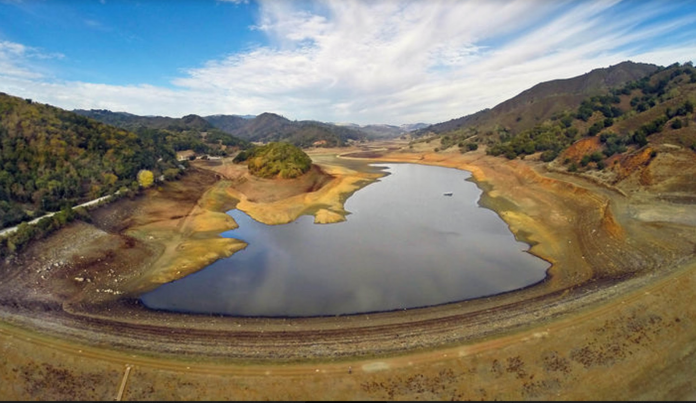I finally made it to Coyote Reservoir this past October, completing the circuit of Santa Clara County’s major water storage facilities. It’s a circuit I began many years ago.
The only urgent reason to recommend a visit to Coyote in late October was that you may never see the water level that low again (so it was just as well the boating season ends there in October most years). Still, it’s a pleasant 15-minute drive from Gilroy and there is ample scenery en route.
The reservoir is the second-largest in the 10-reservoir system. Anderson Reservoir, near Morgan Hill, is easily the largest, with a capacity of about 70 million acre-feet. Coyote had been barely at 5 million acre-feet in October, down from its 23 million-plus capacity.
But now the drought is over around here. The hills are green and Coyote is full, so I tried again on a fabulous Friday in late January, but the road I intended to take had been closed temporarily because of storm damage.
I should have gone over to Anderson, and would have had I been en route to Coe Park from Dunne Avenue in Morgan Hill. See Anderson while you can, because it needs to be drained for earthquake retrofitting as soon as possible. Authorities say if Anderson were to burst, a 35-foot wall of water would hit Morgan Hill in minutes and about 10 feet of water would cover much of the valley from Monterey Bay through Gilroy to San Francisco Bay.
I’ve seen most of the other reservoirs hundreds of times at dozens of levels, largely because I like to travel the roads that run past them, and I am finally in a position to share what I’ve seen with Gilroy’s citizens after traipsing through their midst frequently these past 30 years from elsewhere in the county.
I’m interested in showing readers of this newspaper what it’s like to be a visitor in and around Gilroy and perhaps provide tourists some direction, too. Often I’ll direct tourists and locals alike to my favorites, like Mount Madonna County Park and Uvas Canyon County Park, which remains the nexus for me.
My favorite circuit of the county’s secondary roads leads to those parks and traverses the heart of the reservoir system, taking in Calero, Chesbro and Uvas reservoirs. Uvas has been filled to capacity for a couple of weeks now, and Chesbro is mostly full after having been shockingly dry in 2016.
The drive that encompasses Almaden and Guadalupe reservoirs nearer San Jose has magnificent views of Mount Umunhum in the Santa Cruz Mountains and is the gateway to that soon-to-be-open-to-the-public site.
Guadalupe reservoir is above Los Gatos and little Vasona Lake is near the heart of Los Gatos. Stevens Creek is near Cupertino. Lexington, the third-largest, is visible on Highway 17 between San Jose and Santa Cruz.
Most of those drives are at their best in the spring, when the Central Coast and Bay Area are at their verdant best, with green hills and abundant wildflowers. Fall color can be spectacular in mid-November though it can be elusive some years. The reservoirs are always overshadowed.
But let’s face it, the Santa Cruz Mountains to the west have redwoods and are generally considered the most scenic of the attractions between Gilroy and the coast. Those places can make us overlook the reservoir region. And Fremont Peak is a must-see if you’re based in or near Gilroy.
In general, the eastern hills are more dominated by the abundant but tawny native vegetation, like scrub oak. Although author John Steinbeck said (in “East of Eden”) that he preferred the eastern hills to the western ones, some find those charms too subtle. I practically had Coyote to myself during that October visit, by the way, and often seek that kind of solitude.
Whatever the relative shortcomings, my trek to Coyote provided the scenery quick-fix I craved. The vegetation increased during the climb into the hills, and a canopy of trees provided shade on one of the last hot days of the year.
The lake itself, more than three miles long but narrow, must be quite inviting when you can see it more distinctly from the road, which will soon be the case. And soon after, the visitors will arrive by the boatload.
Colin Seymour is a writer, editor and playwright.












